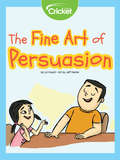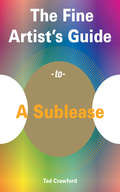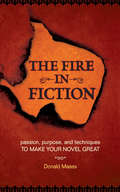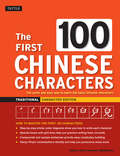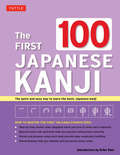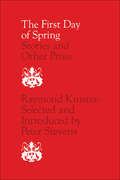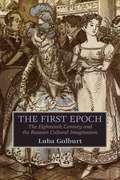- Table View
- List View
The Fine Art of Copyediting: Including Advice To Editors On How To Get Along With Authors, And Tips On Style For Both
by Elsie Myers StaintonMany stylebooks and manuals explain writing, but before the release ten years ago of Elsie Myers Stainton's The Fine Art of Copyediting, few addressed the practices and problems of editing. This handbook has guided users through the editing process for books and journals, with tips on how to be diplomatic when recommending changes, how to edit notes and bibliographies, how to check proofs, and how to negotiate the ethical, intellectual, and emotional problems characteristic of the editorial profession. Now featuring solid advice on computer editing and a new chapter on style, as well as more information on references, bibliographies, indexing, and bias-free writing, The Fine Art of Copyediting, Second Edition offers the same wealth of information that prompted William Safire to commend the first edition in The New York Times Magazine.Complete with helpful checklists for the manuscript, proof, and index stages of book production, as well as an excellent bibliography of reference works useful to the copyeditor, The Fine Art of Copyediting, Second Edition is an indispensable desk reference for writers and editors confronting a host of questions each day. Why use the word "people" instead of "persons?" What precautions are necessary for publishers to avoid libel suits? How can an editor win an author's trust? What type fonts facilitate the copyediting process? How does computer editing work? For experienced and novice copyeditors, writers and students, this is the source for detailed, step-by-step guidance to the entire editorial process.
The Fine Art of Literary Fist-Fighting: How a Bunch of Rabble-Rousers, Outsiders, and Ne'er-do-wells Concocted Creative Nonfiction
by Lee GutkindAn account of the emergence of creative nonfiction, written by the &“godfather&” of the genre In the 1970s, Lee Gutkind, a leather-clad hippie motorcyclist and former public relations writer, fought his way into the academy. Then he took on his colleagues. His goal: to make creative nonfiction an accepted academic discipline, one as vital as poetry, drama, and fiction. In this book Gutkind tells the true story of how creative nonfiction became a leading genre for both readers and writers. Creative nonfiction—true stories enriched by relevant ideas, insights, and intimacies—offered liberation to writers, allowing them to push their work in freewheeling directions. The genre also opened doors to outsiders—doctors, lawyers, construction workers—who felt they had stories to tell about their lives and experiences. Gutkind documents the evolution of the genre, discussing the lives and work of such practitioners as Joan Didion, Tom Wolfe, Norman Mailer, James Baldwin, Zora Neale Hurston, Rachel Carson, Upton Sinclair, Janet Malcolm, and Vivian Gornick. Gutkind also highlights the ethics of writing creative nonfiction, including how writers handle the distinctions between fact and fiction. Gutkind&’s book narrates the story not just of a genre but of the person who brought it to the forefront of the literary and journalistic world.
The Fine Art of Persuasion
by Liz HuyckDo you ever have trouble getting someone to agree with you on something? Reaching your goals can sometimes be hard if someone doesn't see eye-to-eye with you! Learn some tips to improve your persuasion skills as you follow along with two children as they try to convince their parents to get a family pet.
The Fine Artist's Guide to A Sublease
by Tad CrawfordPart of The Fine Artist's Guide series, this classic guide provides information about issues relevant to artists today. It explores several tactics for negotiating a beneficial sublease, how to reduce studio overhead through subletting, and the process of drafting a sublease. This guide demonstrates three types of leases (Form 20, 21, 22) and their provisions, includes a sample sublease contract, and contains helpful negotiation checklists.
The Fine Structure of Polarity Sensitivity (Outstanding Dissertations in Linguistics)
by Lucia M. TovenaFirst Published in 1998. Part of the Outstanding Dissertations in Linguistics series, this study investigates the phenomenon of polarity sensitivity. It proposes a new perspective which focuses on the behaviour and properties of sensitive items and the phrases they form. It originated in the observation that the fine structure of the phenomenon requires a more articulated analysis than the standard one based on licensing conditions.
The Fire and the Tale
by Giorgio Agamben Lorenzo ChiesaWhat is at stake in literature? Can we identify the fire that our stories have lost, but that they strive, at all costs, to rediscover? And what is the philosopher's stone that writers, with the passion of alchemists, struggle to forge in their word furnaces? For Giorgio Agamben, who suggests that the parable is the secret model of all narrative, every act of creation tenaciously resists creation, thereby giving each work its strength and grace. The ten essays brought together here cover works by figures ranging from Aristotle to Paul Klee and illustrate what urgently drives Agamben's current research. As is often the case with his writings, their especial focus is the mystery of literature, of reading and writing, and of language as a laboratory for conceiving an ethico-political perspective that places us beyond sovereign power.
The Fire in Fiction: Passion, Purpose and Techniques to Make Your Novel Great
by Donald MaassMaass, a literary agent and author of other books on novel writing, explains how novelists can instill their stories with passion and keep the reader excited and engaged. He contends that passion is a practical tool that can be drawn on at any time and shows how the day-to-day story development of a novel is key. He provides examples of strong characters, settings, voice, and conflict in published novels, and how to make the impossible feel real and write hyperreality, with exercises for working on writing techniques. There is no bibliography. Annotation ©2009 Book News, Inc. , Portland, OR (booknews. com)
The First 100 Chinese Characters: Simplified Character Edition
by Alison Matthews Laurence MatthewsThis book is a quick and easy way to learn basic Chinese Characters.All beginning students of Chinese struggle to memorize and learn to write the Chinese characters. The First 100 Chinese Characters adopts a structural approach which helps students to quickly master the basic characters that are fundamental to this language.The English meanings, pronunciations in hanyu pinyin and alternate forms (if any) for each Chinese character are presented along with a stroke order guide and spaces for writing practice. Printed with gray guidelines, the stroke order guides are designed to be traced over to teach students the standard sequence of strokes used to write the character. Related compounds and phrases are given to assist in vocabulary building. Three indexes at the back allow the characters to be looked-up by their English meanings, hanyu pinyin pronunciations, or radicals. Extra practice sheets are also provided.This book contains: Step-by-step stroke order diagrams show you how to write each character. Special boxes with grid lines help you practice writing them correctly. Compounds and sample sentences provide easy vocabulary building. Hanyu pinyin romanizations identify and help you pronounce every word.
The First 100 Chinese Characters: Traditional Character Edition
by Alison Matthews Laurence MatthewsThis book is a quick and easy way to learn the first 100 basic Chinese traditional characters.For effective leaning, memorization and practice, each Chinese character is shown separately on a single page, together with its English definitions, hanyu pinyin romanization, alternate form (if any), a stroke order guide and ample space for writing practice. Printed in gray lines, the stroke order guides introduce the student to the standard stroke sequence used in writing the characters, by tracing over them. After learning the correct stroke order, the student can then practice writing the character on their own, thus reinforcing recognition and memorization. Large boxes with grids for correct proportions are provided. Related compounds and phrases containing each character are also included to assist in vocabulary building. Three indexes (alphabetically by the English meanings and the pinyin romanization, and by radicals) are provided at the back of the book for quick and esy reference, along with extra sheets of blank boxes for writing practice. Featured are:The 100 most frequently-used Chinese charactersFoundation characters for the HSK A level language proficiency testStandard hanyu pinyin romanizationsStep-by-step stroke order guides and ample space for writing practiceOver 500 words and phrases containing the basic charactersConcise English definitions
The First 100 Japanese Kanji
by Eriko SatoThis is an invaluable study guide for learning basic Japanese characters.The first 100 Japanese Kanji is intended for beginning students, or experienced speakers who need to practice their written Japanese. Kanji are an essential part of the Japanese language and together with kana (hiragana and katakana) comprise the written component of Japanese.This book presents the kanji characters that are most commonly used. They have been carefully selected for rapid and effective learning. Each kanji's readings, meanings, and common compounds are presented, and romanized pronunciations for English speakers (romanji) are included as well. Printed with gray guidelines, stroke order guides are designed to be traced over to teach students the standard sequence of strokes used to write each character. Three indexes at the back allow the characters to be looked up as with a dictionary or by their readings. Students who wish to practice writing kanji will find extra practice sheets available.This book includes:Step-by-step stroke order diagrams for each characterSpecial boxes with grid lines to practice writing charactersWords and phrases using each kanjiRomanizations (romanji) to help identify and pronounce every word
The First 100 Japanese Kanji
by Eriko SatoThis is an invaluable study guide for learning basic Japanese characters.The first 100 Japanese Kanji is intended for beginning students, or experienced speakers who need to practice their written Japanese. Kanji are an essential part of the Japanese language and together with kana (hiragana and katakana) comprise the written component of Japanese.This book presents the kanji characters that are most commonly used. They have been carefully selected for rapid and effective learning. Each kanji's readings, meanings, and common compounds are presented, and romanized pronunciations for English speakers (romanji) are included as well. Printed with gray guidelines, stroke order guides are designed to be traced over to teach students the standard sequence of strokes used to write each character. Three indexes at the back allow the characters to be looked up as with a dictionary or by their readings. Students who wish to practice writing kanji will find extra practice sheets available.This book includes:Step-by-step stroke order diagrams for each characterSpecial boxes with grid lines to practice writing charactersWords and phrases using each kanjiRomanizations (romanji) to help identify and pronounce every word
The First 50 Pages: Engage Agents, Editors and Readers, and Set Your Novel Up For Success
by Jeff GerkeWhether you're looking to get published or just hoping to hook your reader, first impressions are vital. Compelling opening scenes are the key to catching an agent of editor's attention, and are crucial for keeping your reader engaged.
The First Book: Twentieth-Century Poetic Careers in America
by Jesse Zuba"We have many poets of the First Book," the poet and critic Louis Simpson remarked in 1957, describing a sense that the debut poetry collection not only launched the contemporary poetic career but also had come to define it. Surveying American poetry over the past hundred years, The First Book explores the emergence of the poetic debut as a unique literary production with its own tradition, conventions, and dynamic role in the literary market. Through new readings of poets ranging from Wallace Stevens and Marianne Moore to John Ashbery and Louise Glück, Jesse Zuba illuminates the importance of the first book in twentieth-century American literary culture, which involved complex struggles for legitimacy on the part of poets, critics, and publishers alike. Zuba investigates poets' diverse responses to the question of how to launch a career in an increasingly professionalized literary scene that threatened the authenticity of the poetic calling. He shows how modernist debuts evoke markedly idiosyncratic paths, while postwar first books evoke trajectories that balance professional imperatives with traditional literary ideals. Debut titles ranging from Simpson's The Arrivistes to Ken Chen's Juvenilia stress the strikingly pervasive theme of beginning, accommodating a new demand for career development even as it distances the poets from that demand.Combining literary analysis with cultural history, The First Book will interest scholars and students of twentieth-century literature as well as readers and writers of poetry.
The First Day of Spring: Stories and Other Prose
by Raymond Knister Douglas Lochhead Peter StevensRaymond Knister had a strong sense of commitment both to his own career and to literature, particularly Canadian literature. In his ten working years he proved himself a prolific writer with wide-ranging interests. Although his work has appeared in many anthologies of Canadian literature, there remains a great deal of out of print or unpublished material. This volume brings together not only for his more well-known stories but also all his unpublished stories, a few travel pieces, and several examples of his literary criticism. Knister's stories are often strongly regional, and draw on rural Ontario for their setting and characters. Collected together here for the first time is a group of sketches dealing anecdotally with life in a village in southwestern Ontario. Also included are two stories arising from his experiences as a cab driver in Chicago in the 1920s, 'Innocent Man,' and 'Hackman's Night.' His essays focusing on literary matters and the traditions and problems of Canadian literature show a keenly critical mind. The First Day of Spring is an important rediscovery of one of Canada's best writers of the 1920s.
The First Days of Class: A Practical Guide for the Beginning Teacher
by Rebecca WilkeThis easy-to-use, step-by-step guide takes you through everything you need to know in your first days, weeks, and months as a new teacher, from developing your plan book and filing system in August to updating your grade book and celebrating your success in June. Chapters cover diverse learners, classroom organization and management, curriculum and instruction, lesson planning, grading systems, professional development, and more. Practical and specific advice helps you build the right classroom environment, create “essential file folders,” make a curriculum calendar, and even find the right wall art!The First Days of Class provides all the tools of the trade for new, substitute, returning, and emergency credential teachers, including: Short, easy-to-reference sections within each chapterTip boxes at the end of every chapterClassroom material samples, including “Our Classroom Rules” and a calendar of multicultural celebrationsResources that include a “A Teacher’s Ten Commandments,” Recommended Reading, and Educational websites.
The First English Dictionary 1604
by John Simpson Robert CawdreyEnglish is one of the most complicated languages to learn, and its constantly evolving vocabulary certainly doesn't help matters. For centuries, men and women have striven to chronicle and categorize the expressions of the English language, and Samuel Johnson is usually thought to be their original predecessor.But that lineage is wrong: Robert Cawdrey published his Table Alphabeticall in 1604, 149 years before Johnson's tome, and it is now republished here for the first time in over 350 years. This edition, prepared from the sole surviving copy of the first printing, documents Cawdrey's fascinating selection of 2,543 words and their first-ever definitions. Cawdrey subtitled his dictionary "for the benefit of Ladies, Gentlewomen, and other unskilled folk," for his aim was not to create a comprehensive catalog, but rather an in-depth guide for the lesser educated who might not know the "hard usual English wordes, borrowed from the Hebrew, Greeke, Latine, or French." Each entry reveals an intriguing facet of early modern life and the cultural mores of the time. There are familiar terms--"geometrie" was defined as "the art of measuring the earth," and a "concubine" was described as a "harlot, or light huswife"--and amusingly idiomatic definitions: "prodigall" is "too riotous in spending," while "hecticke" is "inflaming the hart, and soundest parts of the bodie."
The First Epoch
by Luba GolburtModern Russian literature has two "first" epochs: secular literature's rapid rise in the eighteenth century and Alexander Pushkin's Golden Age in the early nineteenth. In the shadow of the latter, Russia's eighteenth-century culture was relegated to an obscurity hardly befitting its actually radical legacy. And yet the eighteenth century maintains an undeniable hold on the Russian historical imagination to this day. Luba Golburt's book is the first to document this paradox. In formulating its self-image, the culture of the Pushkin era and after wrestled far more with the meaning of the eighteenth century, Golburt argues, than is commonly appreciated. Why did nineteenth-century Russians put the eighteenth century so quickly behind them? How does a meaningful present become a seemingly meaningless past? Interpreting texts by Lomonosov, Derzhavin, Pushkin, Viazemsky, Turgenev, Tolstoy, and others, Golburt finds surprising answers, in the process innovatively analyzing the rise of periodization and epochal consciousness, the formation of canon, and the writing of literary history.
The First European: A History of Alexander in the Age of Empire
by Pierre Briant“A truly remarkable forgotten chapter of European intellectual history, laid out with passion and integrity.” (The Wall Street Journal)The exploits of Alexander the Great were so remarkable that for centuries after his death the Macedonian ruler seemed a figure more of legend than of history. Thinkers of the European Enlightenment, searching for ancient models to understand contemporary affairs, were the first to critically interpret Alexander’s achievements. As Pierre Briant shows, in the minds of eighteenth-century intellectuals and philosophers, Alexander was the first European: a successful creator of empire who opened the door to new sources of trade and scientific knowledge, and an enlightened leader who brought the fruits of Western civilization to an oppressed and backward “Orient.”In France, Scotland, England, and Germany, Alexander the Great became an important point of reference in discourses from philosophy and history to political economy and geography. Voltaire, Montesquieu, and Robertson asked what lessons Alexander’s empire-building had to teach modern Europeans. They saw the ancient Macedonian as the embodiment of the rational and benevolent Western ruler, a historical model to be emulated as Western powers accelerated their colonial expansion into Asia, India, and the Middle East.“This important work. . . . confirms once more that the life-trajectory of the Macedonian conqueror remains an inexhaustible cultural resource.” —Sanjay Subrahmanyam, University of California, Los Angeles, author of Empires Between Islam and Christianity
The First Five Pages
by Noah LukemanIF YOU'RE TIRED OF REJECTION, THIS IS THE BOOK FOR YOU. Whether you are a novice writer or a veteran who has already had your work published, rejection is often a frustrating reality. Literary agents and editors receive and reject hundreds of manuscripts each month. While it's the job of these publishing professionals to be discriminating, it's the job of the writer to produce a manuscript that immediately stands out among the vast competition. And those outstanding qualities, says New York literary agent Noah Lukeman, have to be apparent from the first five pages. The First Five Pagesreveals the necessary elements of good writing, whether it be fiction, nonfiction, journalism, or poetry, and points out errors to be avoided, such as* A weak opening hook* Overuse of adjectives and adverbs* Flat or forced metaphors or similes* Melodramatic, commonplace or confusing dialogue* Undeveloped characterizations and lifeless settings* Uneven pacing and lack of progressionWith exercises at the end of each chapter, this invaluable reference will allow novelists, journalists, poets and screenwriters alike to improve their technique as they learn to eliminate even the most subtle mistakes that are cause for rejection. The First Five Pageswill help writers at every stage take their art to a higher -- and more successful -- level.
The First Frame
by Pannill CampIn the late eighteenth century, a movement to transform France's theatre architecture united the nation. Playwrights, philosophers, and powerful agents including King Louis XV rejected the modified structures that had housed the plays of Racine and Molière, and debated which playhouse form should support the future of French stagecraft. In The First Frame, Pannill Camp argues that these reforms helped to lay down the theoretical and practical foundations of modern theatre space. Examining dramatic theory, architecture, and philosophy, Camp explores how architects, dramatists, and spectators began to see theatre and scientific experimentation as parallel enterprises. During this period of modernisation, physicists began to cite dramatic theory and adopt theatrical staging techniques, while playwrights sought to reveal observable truths of human nature. Camp goes on to show that these reforms had consequences for the way we understand both modern theatrical aesthetics and the production of scientific knowledge in the present day.
The First German Theatre (Routledge Revivals): Schiller, Goethe, Kleist and Büchner in Performance
by Michael PattersonFirst published in 1990. The book surveys of the development of German theatre from a market sideshow into an important element of cultural life and political expression. It examines Schiller as ‘theatre poet’ at Mannheim, Goethe’s work as director of the court theatre at Weimar, and then traces the rapid commercial decline that made it difficult for Kleist and impossible for Büchner to see their plays staged in their own lifetime. Four representative texts are analysed: Schiller’s The Robbers, Goethe’s Iphigenia on Tauris, Kleist’s The Prince of Homburg, and Büchner’s Woyzeck. This title will be of interest to students of theatre and German literature.
The First Inauguration: George Washington and the Invention of the Republic
by Stephen Howard Browne"Among the vicissitudes incident to life, no event could have filled me with greater anxieties than that of which the notification was transmitted by your order, and received on the fourteenth day of the present month." With these words to the assembled members of the Senate and House of Representatives on April 30, 1789, George Washington inaugurated the American experiment. It was a momentous occasion and an immensely important moment for the nation. Never before had a people dared to invent a system of government quite like the one that Washington was preparing to lead, and the tensions between hope and skepticism ran high.In this book, distinguished scholar of early America Stephen Howard Browne chronicles the efforts of the first president of the United States of America to unite the nation through ceremony, celebrations, and oratory. The story follows Washington on his journey from Mount Vernon to the site of the inauguration in Manhattan, recounting the festivities—speeches, parades, dances, music, food, and flag-waving—that greeted the president-elect along the way. Considering the persuasive power of this procession, Browne captures in detail the pageantry, anxiety, and spirit of the nation to arrive at a more nuanced and richly textured perspective on what it took to launch the modern republican state. Compellingly written and artfully argued, The First Inauguration tells the story of the early republic—and of a president who, by his words and comportment, provides a model of leadership and democratic governance for today.
The First Inauguration: George Washington and the Invention of the Republic
by Stephen Howard Browne“Among the vicissitudes incident to life, no event could have filled me with greater anxieties than that of which the notification was transmitted by your order, and received on the fourteenth day of the present month.”With these words to the assembled members of the Senate and House of Representatives on April 30, 1789, George Washington inaugurated the American experiment. It was a momentous occasion and an immensely important moment for the nation. Never before had a people dared to invent a system of government quite like the one that Washington was preparing to lead, and the tensions between hope and skepticism ran high.In this book, distinguished scholar of early America Stephen Howard Browne chronicles the efforts of the first president of the United States of America to unite the nation through ceremony, celebrations, and oratory. The story follows Washington on his journey from Mount Vernon to the site of the inauguration in Manhattan, recounting the festivities—speeches, parades, dances, music, food, and flag-waving—that greeted the president-elect along the way. Considering the persuasive power of this procession, Browne captures in detail the pageantry, anxiety, and spirit of the nation to arrive at a more nuanced and richly textured perspective on what it took to launch the modern republican state. Compellingly written and artfully argued, The First Inauguration tells the story of the early republic—and of a president who, by his words and comportment, provides a model of leadership and democratic governance for today.
The First Last Man: Mary Shelley and the Postapocalyptic Imagination
by Eileen M. HuntBeyond her most famous creation—the nightmarish vision of Frankenstein’s Creature—Mary Shelley’s most enduring influence on politics, literature, and art perhaps stems from the legacy of her lesser-known novel about the near-extinction of the human species through war, disease, and corruption. This novel, The Last Man (1826), gives us the iconic image of a heroic survivor who narrates the history of an apocalyptic disaster in order to save humanity—if not as a species, then at least as the practice of compassion or humaneness. In visual and musical arts from 1826 to the present, this postapocalyptic figure has transmogrified from the “last man” into the globally familiar filmic images of the “invisible man” and the “final girl.”Reading Shelley’s work against the background of epidemic literature and political thought from ancient Greece to Covid-19, Eileen M. Hunt reveals how Shelley’s postapocalyptic imagination has shaped science fiction and dystopian writing from H. G. Wells, M. P. Shiel, and George Orwell to Octavia Butler, Margaret Atwood, and Emily St. John Mandel. Through archival research into Shelley’s personal journals and other writings, Hunt unearths Shelley’s ruminations on her own personal experiences of loss, including the death of young children in her family to disease and the drowning of her husband, Percy Bysshe Shelley. Shelley’s grief drove her to intensive study of Greek tragedy, through which she developed the thinking about plague, conflict, and collective responsibility that later emerges in her fiction. From her readings of classic works of plague literature to her own translation of Sophocles’s Oedipus Rex, and from her authorship of the first major modern pandemic novel to her continued influence on contemporary popular culture, Shelley gave rise to a tradition of postapocalyptic thought that asks a question that the Covid-19 pandemic has made newly urgent for many: What do humans do after disaster?


